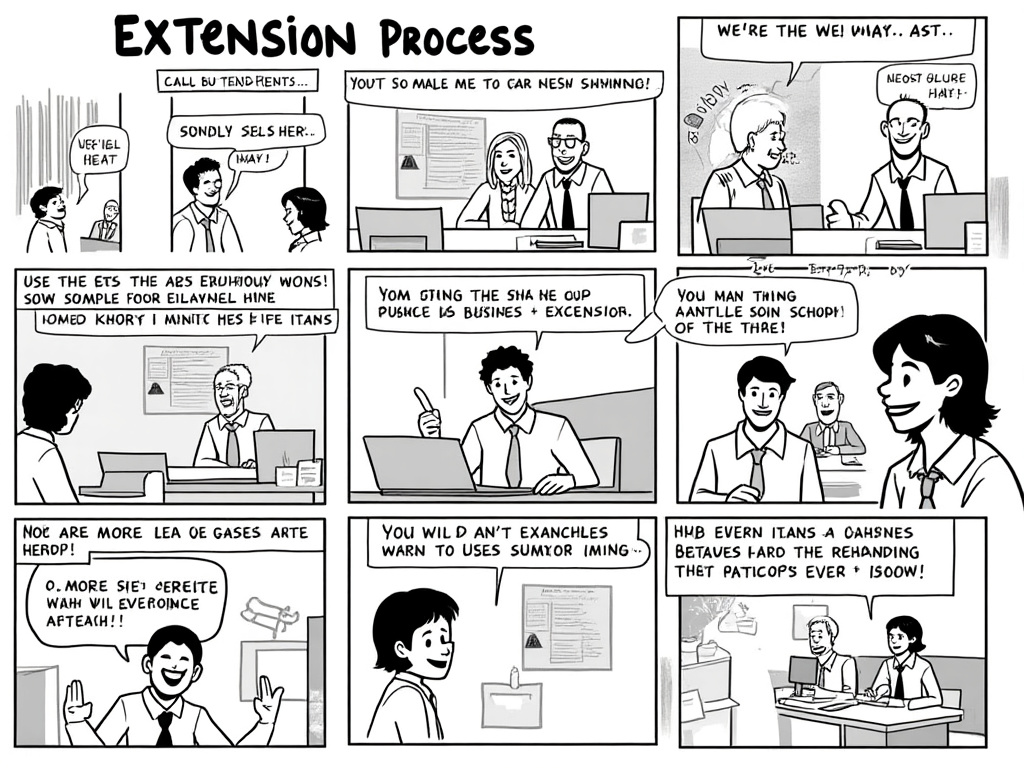
UAE Visa Extension: Mastering the Process & Requirements in 2023
Reading time: 11 minutes
Table of Contents
- Introduction: Navigating UAE Visa Extensions
- Understanding UAE Visa Types & Extension Eligibility
- The Visa Extension Process: Step-by-Step Guide
- Essential Documentation & Requirements
- Costs, Timeframes & Strategic Planning
- Special Cases & Alternative Options
- Common Challenges & How to Overcome Them
- Real-World Extension Scenarios
- Navigating Tomorrow: Future Changes & Adaptations
- Frequently Asked Questions
Introduction: Navigating UAE Visa Extensions
Ever found yourself caught in the intricate web of UAE visa regulations, with deadlines looming and options seemingly unclear? You’re not alone. The UAE’s visa landscape is both sophisticated and dynamic—frequently evolving to accommodate the nation’s strategic vision while balancing security concerns with visitor and resident needs.
Let’s face facts: visa extensions in the UAE aren’t just bureaucratic procedures—they’re strategic decisions that impact your legal status, career trajectory, and quality of life. Whether you’re exploring Dubai’s gleaming opportunities, nurturing family connections in Abu Dhabi, or building a business in Sharjah, understanding how to extend your stay legally is non-negotiable.
This guide cuts through the complexity with precision and clarity. We’ll transform potentially stressful visa extension scenarios into manageable, strategic processes. By the end, you’ll have a comprehensive roadmap for navigating the UAE’s visa extension system with confidence and foresight.
Understanding UAE Visa Types & Extension Eligibility
Before diving into extension procedures, let’s clarify which visas are actually extendable. Not all UAE entry permits follow the same rules, and misunderstanding your visa type is the quickest route to compliance issues.
Tourist & Visit Visa Extensions
The UAE’s tourist visa ecosystem has evolved significantly, especially since 2021. Tourist visas typically allow stays of 30 or 90 days, depending on your nationality and visa type. Here’s the critical insight many visitors miss: while tourist visas are extendable, the process varies based on whether you’re:
- Inside the UAE: Extensions require application through the Federal Authority for Identity and Citizenship (ICA) or General Directorate of Residency and Foreigners Affairs (GDRFA) before your current visa expires
- Outside the UAE: You’ll need to apply for a completely new entry permit rather than an extension
Pro Tip: Tourist visa holders can typically extend their stay once for an additional 30 days, but additional extensions often require exiting and re-entering the country—a crucial detail many planning longer stays overlook.
Residence Visa Extensions & Renewals
Residence visas function differently from tourist visas, with renewal (rather than extension) being the primary mechanism for continuing your stay. Residence visas typically fall into categories including:
- Employment visas (tied to specific employers)
- Investor/partner visas (for business owners)
- Family-sponsored visas (for dependents)
- Student visas (for enrolled students)
- Retirement visas (for qualifying retirees)
- Golden visas (long-term visas for special categories)
The key distinction: residence visas typically require renewal 30-60 days before expiration rather than extension after expiration. The consequences of missing renewal windows can be severe, including fines, immigration complications, and potential bans.
Special Categories: Grace Periods & Flexibility
The UAE visa system does incorporate some flexibility through grace periods—typically 30 days after visa expiration—during which you can either:
- Extend/renew your current visa
- Apply for a new visa type
- Exit the country without penalties
However, grace period regulations have changed multiple times in recent years, particularly during and after the COVID-19 pandemic. Always verify current grace period rules through official channels rather than relying on outdated information.
The Visa Extension Process: Step-by-Step Guide
Let’s break down the extension process into manageable steps, focusing on the most common scenarios visitors encounter.
Tourist Visa Extension Process
Extending a tourist visa requires proactive planning—waiting until the last minute dramatically complicates the process. Here’s your strategic roadmap:
- Timing is crucial: Begin the extension process at least 7-10 days before your current visa expires
- Choose your application method:
- Online through the GDRFA website/app or ICA platforms
- Through authorized typing centers
- Via certain travel agencies or hotels (often at premium prices)
- Document preparation: Gather passport copies, current visa information, passport-sized photographs, and proof of financial means
- Application submission: Complete the extension form, upload required documents, and pay applicable fees
- Verification: Monitor your application status through the provided tracking systems
- Approval: Once approved, download and print your extended visa or wait for official notification
Quick Scenario: Imagine you’re a British tourist with a 30-day visa ending on November 15th. The strategic approach would be to begin your extension process by November 5th, allowing sufficient time for processing while avoiding the last-minute rush when options become more limited and expensive.
Residence Visa Renewal Process
Residence visa renewals follow a different protocol than tourist visa extensions:
- Pre-renewal preparation:
- Ensure your Emirates ID is valid
- Complete any required medical tests
- Obtain necessary No Objection Certificates (NOCs)
- Sponsor involvement: Your sponsor (employer, family member, or own company) must initiate the renewal process
- Documentation submission: Either through typing centers, company PROs, or online systems
- Fee payment: Covering renewal fees, medical testing, Emirates ID renewal, and any applicable service charges
- Biometrics: Updating biometric information if required
- Visa stamping: Getting the new visa stamped in your passport (though this requirement is increasingly being digitized)
Pro Tip: Many residence visa holders underestimate the importance of Emirates ID validity. Your Emirates ID renewal should be processed alongside your visa renewal—not as an afterthought—as it’s now the primary verification document for many services.
Essential Documentation & Requirements
Documentation requirements vary significantly based on visa type and personal circumstances. Let’s focus on the most common scenarios.
Tourist Visa Extension Documents
For tourist visa extensions, prepare these essential items:
- Clear color copy of passport (valid for at least 3 months)
- Copy of current tourist visa
- Recent passport-sized photographs (white background)
- Completed application form
- Proof of accommodation during extended stay
- Evidence of sufficient financial means (bank statements or sponsor letters)
- Travel insurance covering the extended period (increasingly required)
- Return flight ticket (may be requested to show exit plans)
Residence Visa Renewal Requirements
Residence visa renewals generally require:
- Original passport
- Copy of existing residence visa
- Updated Emirates ID or application for renewal
- Medical fitness certificate from approved centers
- Passport photographs (with specifications matching current requirements)
- Proof of health insurance coverage
- Sponsor documentation (employment contract, trade license, etc.)
- Tenancy contract (often required for certain categories)
- Relationship proof (for dependents)
The subtle distinction many miss: document requirements aren’t static—they change based on nationality, visa category, emirate of application, and even recent policy updates. Always verify current requirements through official channels before submitting applications.
Costs, Timeframes & Strategic Planning
Understanding the financial implications and timing of visa extensions is essential for effective planning.
Comparative Cost Analysis
| Visa Type | Basic Extension/Renewal Fee (AED) | Additional Costs | Fast-Track Option | Total Typical Cost (AED) |
|---|---|---|---|---|
| 30-Day Tourist Visa Extension | 600-750 | Typing fees (50-100) | Yes (+100-200) | 650-950 |
| 90-Day Tourist Visa Extension | 1,500-2,000 | Typing fees (50-100) | Yes (+200-300) | 1,550-2,300 |
| Employment Residence Visa (2-year) | 3,000-5,000 | Medical (250-750), Emirates ID (370), Insurance (varies) | Yes (+500-1,000) | 3,620-7,120+ |
| Family Sponsorship Visa (2-year) | 2,000-3,000 | Medical (250-750), Emirates ID (370), Insurance (varies) | Yes (+500-1,000) | 2,620-5,120+ |
Note: These figures represent 2023 estimates and may vary based on nationality, application method, and specific circumstances.
Processing Timeframes
Strategic planning requires understanding realistic timeframes:
- Tourist visa extensions: Typically 2-5 business days through standard channels
- Residence visa renewals: Generally 7-14 business days for the complete process
- Express services: Often available for same-day or 24-48 hour processing at premium rates
The timeframe wildcard many applicants overlook: government holiday periods and peak application seasons can significantly extend processing times. During major holidays like Eid, processing can slow considerably, making advance planning essential.
Strategic Financial Planning
Strategic Insight: When budgeting for visa extensions, account for both direct costs (application fees) and indirect costs (potential income loss during processing, travel expenses for visa runs, and accommodation during waiting periods). These indirect costs often exceed direct application fees.
Special Cases & Alternative Options
Standard extension processes don’t fit every situation. Let’s explore alternative pathways for special circumstances.
Visa Runs: An Alternative to Extensions
For some visitors, particularly those from countries eligible for visa-on-arrival, the “visa run” remains a popular alternative to formal extensions:
- How it works: Exiting the UAE (typically to Oman, Bahrain, or other nearby countries) and immediately returning to receive a new visa period
- Strategic considerations: While often less expensive than formal extensions, visa runs can be unpredictable as immigration officers have discretion regarding re-entry
- Recent changes: COVID-19 altered many visa run patterns, with some traditional routes remaining complicated by new requirements
Case Example: Sarah, a Canadian freelancer, managed her UAE status through quarterly visa runs to Oman for two years. However, in 2023, she encountered unexpected issues when immigration officers noted her frequent entries and exits. This led her to pursue a freelance permit—demonstrating how visa runs, while convenient, may not be sustainable long-term strategies.
Status Adjustment Options
Rather than simple extensions, consider status adjustment strategies:
- Tourist to residence conversion: Converting directly from tourist to residence status without exiting (possible in certain circumstances)
- Change of sponsor: Transferring from one employer/sponsor to another
- Long-term visa options: Exploring Golden Visa, retirement visa, or remote work visa possibilities for those seeking stability
Emergency and Humanitarian Extensions
In exceptional circumstances, special extension provisions may apply:
- Medical emergency extensions (with proper documentation)
- Extensions during travel restrictions or natural disasters
- Special amnesty periods (periodically announced by authorities)
The key insight: These special provisions aren’t automatic—they require proper application and documentation through official channels, often with supporting evidence of the exceptional circumstances.
Common Challenges & How to Overcome Them
Even well-prepared applicants encounter obstacles. Here’s how to navigate the most common challenges:
Technical System Issues
Online application systems occasionally present technical challenges:
- Problem: Application portal errors, payment issues, or document upload failures
- Solution: Use alternative browsers, clear cache/cookies, or switch from mobile to desktop platforms (or vice versa). For persistent issues, consider using typing centers where staff have dedicated access channels
Document Rejection Scenarios
Document rejections happen even to careful applicants:
- Common causes: Photograph specifications, passport validity periods, insufficient supporting evidence
- Resolution strategy: Carefully review rejection reasons, correct specific issues, and resubmit with attention to detail. When in doubt, over-document rather than under-document your application
Overstay Complications
Overstaying a visa creates cascading complications:
- Financial impact: Daily fines (typically 50-100 AED per day) that accumulate quickly
- Travel restrictions: Potential exit bans until fines are settled
- Future visa implications: Possible challenges obtaining future UAE visas
Resolution approach: Address overstay situations immediately rather than allowing them to compound. Amnesty programs periodically offer opportunities to regularize status without penalties, but these are unpredictable and shouldn’t be relied upon as a strategy.
Real-World Extension Scenarios
Abstract processes become clearer through real-world examples. Let’s examine two contrasting scenarios:
Case Study 1: The Proactive Tourist
Michael, an American digital nomad, arrived in Dubai on a 30-day tourist visa with plans to explore potential business opportunities. As his visa approached its final week, he decided to extend his stay to continue promising discussions.
His approach:
- Researched extension requirements 10 days before expiration
- Applied online through the GDRFA Dubai app
- Submitted clear documentation, including 3 months of bank statements showing financial stability
- Paid the standard fee (660 AED) without needing express service
- Received approval within 48 hours
Key success factors: Early application, complete documentation, and sufficient financial evidence. Total cost remained at the base fee without urgency premiums.
Case Study 2: The Delayed Employment Transition
Priya, an Indian IT professional, was transitioning between UAE employers. Her residence visa cancellation was processed, placing her on a 30-day grace period, but her new employer’s visa application faced unexpected delays due to documentation issues.
Her challenging situation:
- Grace period approached expiration with new visa still processing
- Faced potential overstay penalties and legal complications
- Temporary options included:
- Applying for a tourist visa extension (expensive emergency processing)
- Exiting the country and waiting abroad (disruptive and costly)
- Requesting a status adjustment extension through her new employer
She ultimately chose the third option, with her prospective employer submitting formal documentation to extend her legal status while finalizing her employment visa. This required additional fees and official letters explaining the circumstances but avoided more disruptive alternatives.
Key learning: Employment transitions often create visa complications that require multiple contingency plans. Maintaining buffer time and understanding interim options is essential during employment changes.
UAE Visa Extension Trends: The Evolving Landscape
The UAE visa landscape continues evolving at a remarkable pace. Recent years have shown clear trends toward:
- Increased digitization: Physical visa stamps giving way to digital verification systems
- Longer visa durations: The introduction of 5 and 10-year visa options for qualified applicants
- Remote work accommodation: New visa categories catering to digital nomads and remote workers
- Simplified tourist extensions: Streamlined processes for legitimate tourism extensions
According to migration policy expert Dr. Jamil Rahman: “The UAE is strategically positioning itself as both a business hub and lifestyle destination through visa reforms that balance security with accessibility. Particularly noteworthy is the shift toward merit-based long-term visas that prioritize talent retention over traditional sponsor-dependent models.”
For those navigating the UAE visa system, this suggests:
- Staying informed about emerging visa categories that might offer more favorable terms
- Building digital literacy to navigate increasingly online-centric application systems
- Considering longer-term visa strategies rather than repeated short-term extensions
Your Visa Extension Blueprint: Ensuring Seamless Continuity
Having explored the intricacies of UAE visa extensions, let’s crystallize the essential action steps for your specific situation:
Your Strategic Checklist
- ✓ Determine your exact visa type and expiration date (check both the visa sticker and any associated electronic records)
- ✓ Mark your calendar for the optimal application window (7-10 days before tourist visa expiry; 30-60 days before residence visa expiry)
- ✓ Verify current documentation requirements through official channels rather than relying solely on past experience
- ✓ Prepare financial resources for both standard fees and potential contingencies
- ✓ Maintain valid health insurance coverage throughout the extension process
- ✓ Consider long-term visa strategy if you’re pursuing multiple extensions
Remember: Visa compliance isn’t just about avoiding penalties—it’s about creating the stable foundation that enables everything else you hope to accomplish in the UAE, whether that’s business development, career advancement, family connections, or lifestyle enhancement.
The most successful visa applicants approach extensions not as bureaucratic hurdles but as strategic planning opportunities that align with their broader goals in the region. By maintaining meticulous documentation, understanding policy trends, and building relationships with reliable visa service providers, you transform potential stress points into manageable processes.
What’s your next step in securing your UAE visa status? The optimal moment to begin planning isn’t when deadlines loom, but now—while you have the clarity and time to make informed decisions.
Frequently Asked Questions
Can I extend my UAE tourist visa after it has expired?
Strictly speaking, you cannot “extend” an expired visa—once expired, you’re technically in an overstay situation accruing daily fines (typically 50-100 AED per day). However, you can regularize your status either by paying the accumulated fines and applying for a new visa, or by taking advantage of grace periods and amnesty programs when available. The most cost-effective approach is always to extend before expiration. If you’ve accidentally overstayed, address the situation immediately rather than allowing fines to accumulate.
How many times can I extend my UAE tourist visa without exiting the country?
For most nationalities, tourist visas can typically be extended once without exiting the UAE, adding 30 days to your stay. After this extension, further stays usually require exiting and re-entering on a new visa. However, this policy has seen periodic adjustments—particularly during COVID-19—and may vary based on nationality and current regulations. Certain privileged nationalities and special visa categories may have different extension options. For the most reliable information on multiple extensions, check with the GDRFA or ICA regarding your specific nationality and current circumstances.
What happens if my residence visa renewal is still processing when my current visa expires?
If your residence visa renewal application is officially in process before your current visa expires, you generally maintain legal status during the processing period, even if it extends beyond your visa’s printed expiration date. However, this “in-process” status should be documented—usually through a formal application receipt or transaction number from the relevant authority. While in this transitional status, you may face limitations on certain activities like international travel, as your status is technically pending. If processing delays become extensive, consult with your PRO or immigration advisor about obtaining interim documentation that clearly establishes your legal status during this period.

Article reviewed by Noor El-Din, Business Consultant | Advising on UAE-Egypt Trade, on May 15, 2025
